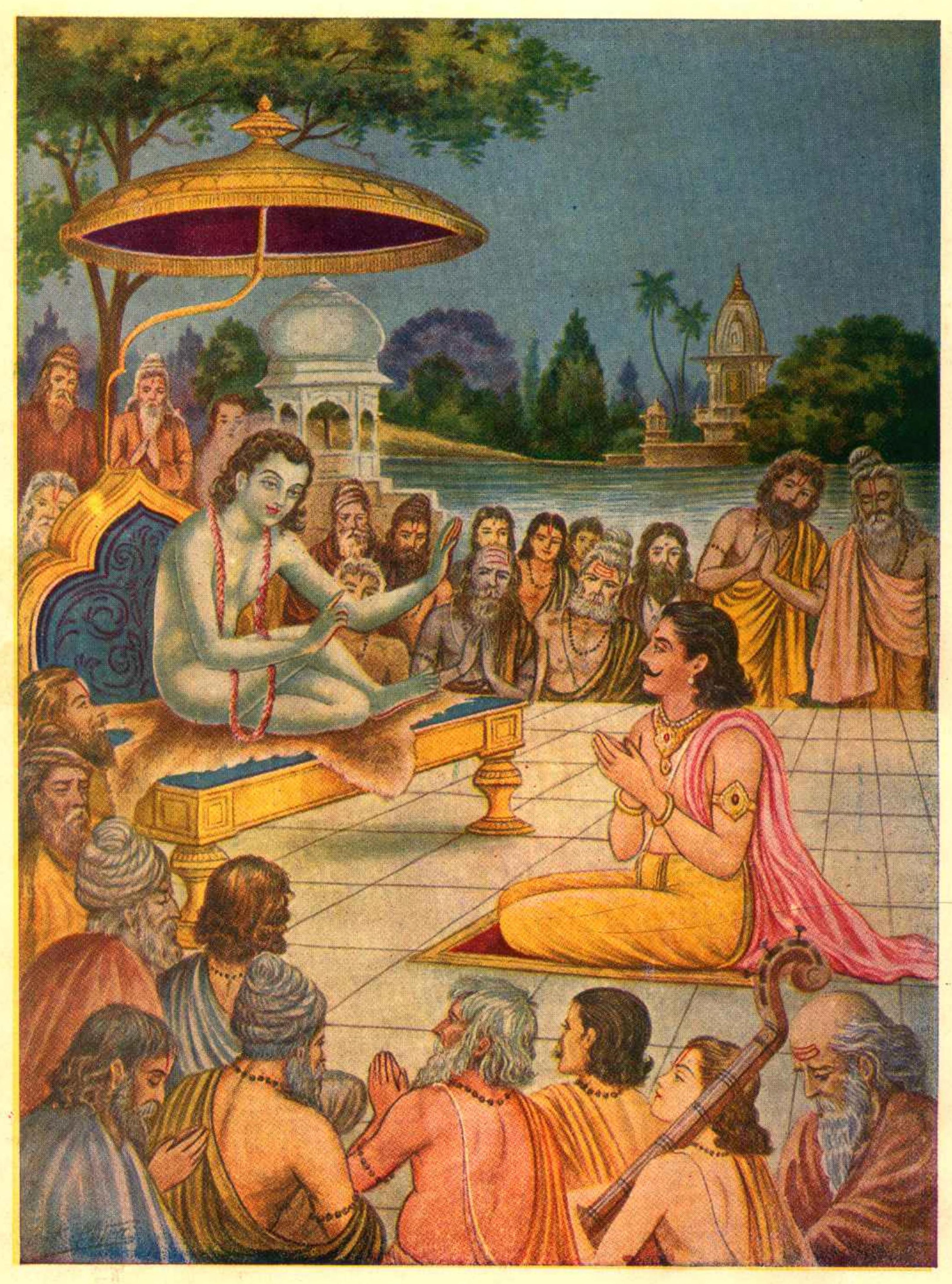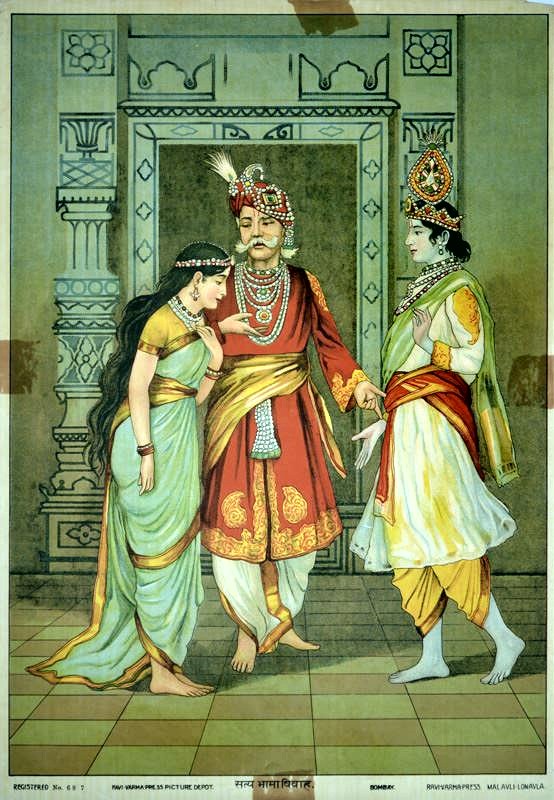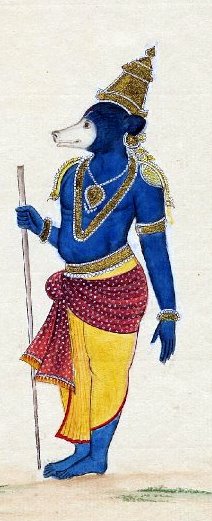|
Syamantaka
The Syamantaka () is a legendary jewel featured in Hindu texts, Hindu literature, regarded to be blessed with magical powers. It is described to be a ruby. The jewel is described to protect its owner if they were virtuous and good, but bring evil to them if they were not. Origin The fact of the Syamantaka appears in the ''Vishnu Purana'' and the ''Bhagavata Purana''. The jewel originally belonged to the God of the Sun, Surya, who wore it around his neck. It was said that whichever land possessed this jewel would never encounter any calamities such as droughts, floods, earthquakes or famines, and would always be full of prosperity and plenitude. Wherever the jewel remained, it would produce for the keeper eight ''bhāras'' of gold daily. ("Four rice grains are called one guñjā; five guñjās, one paṇa; eight paṇas, one karṣa; four karṣas, one pala; and one hundred palas, one tulā. Twenty tulās make up one bhāra.") Since there are about 3,700 grains of rice in an oun ... [...More Info...] [...Related Items...] OR: [Wikipedia] [Google] [Baidu] |
Satrajita
Satrajit (), also rendered Satrajita, is a Yadava king in Hinduism. He had ten wives and three daughters named Satyabhama, Bratini, and Prasvapini who were all married to Krishna. He is described to be a great devotee of Surya, the sun god. He is known for his role in the legend of the Syamantaka jewel. Legend Gaining the Syamantaka The Bhagavata Purana narrates that Satrajit was a great devotee of sun god, Surya. Greatly pleased, Surya offered him the dazzling Syamantaka as a present, which had the power of conferring great wealth upon its owner. When Satrajit wore the jewel, its brilliance was such that he was mistaken as the sun god himself. During a meeting, Krishna asked Satrajit to let King Ugrasena have the jewel, so that it could be used for the good of all. Proud of his possession, Satrajit refused to part with the Syamantaka. Disappearance of the jewel One day, Satrajit's brother, Prasena, borrowed the jewel from Satrajit, and went into a forest for hunting. How ... [...More Info...] [...Related Items...] OR: [Wikipedia] [Google] [Baidu] |
Jambavati
Jambavati () is chronologically the second '' Ashtabharya'' of the Hindu god Krishna. She is the only daughter of the bear-king Jambavan. Krishna marries her when he defeats her father, Jambavan, in his quest to retrieve the stolen Syamantaka jewel. Nomenclature Jambavati, a patronymic, means daughter of Jambavan. Sridhara, a commentator on the ''Bhagavata Purana'', identifies her with Krishna's wife Rohini. However, another commentator, Ratnagarbha, disagrees. The '' Harivamsa'' also suggests that Rohini may be an alternate name of Jambavati. Jambavati is also given the epithets Narendraputri and Kapindraputra. Legend In the epic ''Mahabharata'', Jambavan is introduced as Jambavati's father. The ''Bhagavata Purana'' and the ''Harivamsa'' calls him the king of bears. Jambavati is an incarnation of the goddess Lakshmi, along with the junior wives of Krishna, as well as the Ashtabharya. Marriage to Krishna The marriage of Jambavati and Satyabhama to Krishna is closely li ... [...More Info...] [...Related Items...] OR: [Wikipedia] [Google] [Baidu] |
Akrura
Akrura () is a Yadava prince in Hinduism, best known for being the uncle of the deity Krishna. The son of Śvaphalka and Gandini, a daughter of the king of Kashi,Garg, pp. 305-306. he is instructed by Kamsa to drive his nephews, Krishna and Balarama, to a Dhanuryāga (festival of arms) at Mathura, where they were to be slain. He bears witness to the vishvarupa (theophany) of Krishna during this journey. Akrura becomes the owner of the Syamantaka jewel after the death of its previous owner, Satrajit. He is slain during the internecine Yadu massacre at Prabhasa. Legend According to the Harivamsha, Akrura marries Ugraseni, the daughter of Ugrasena, who gives birth to two sons, Sudeva and Upadeva. F.E. Pargiter states that Akrura weds Sutanu, the daughter of Ahuka, and with her he had two sons, Devaka and Updevaka. He is said to have reigned at Dvaraka, and Pargiter believes that the family's chiefdom stretched as far back as Vrishni. Charioteer of Krishna and Balarama Ak ... [...More Info...] [...Related Items...] OR: [Wikipedia] [Google] [Baidu] |
Kritavarma
Kritavarma (, ) is a warrior from the Yaduvamsha in Hindu mythology. He appears as a minor character in the Mahabharata, fighting in the Kurukshetra war for the Kauravas. According to F.E. Pargiter, he was the son of Hṛidika, born in the Andhaka clan of the Yadu dynasty.Pargiter, F.E. (1972). ''Ancient Indian Historical Tradition'', Delhi: Motilal Banarsidass, p.105. Legend Syamantaka theft Kritavarma is said to have encouraged, or in some accounts, participated in the theft of the legendary Syamantaka jewel from King Satrajit. Along with his friend Akrura, he is said to have caused Shatadhanva to murder Satrajit, and steal the jewel for himself. Shatadhanva was subsequently slain by Krishna, though he no longer had the jewel, having given it to Akrura and Kritavarma for safekeeping. When a famine broke out in Dvaraka, or in other accounts, due to the discovery of Akrura's possession of the Syamantaka, both Kritavarma and he were summoned to the city to hand over the j ... [...More Info...] [...Related Items...] OR: [Wikipedia] [Google] [Baidu] |
Yadava
The Yadava (), not to be confused with Yadav, were an ancient Indian people who believed to have descended from Yadu (legendary king), Yadu, a legendary king of Chandravamsha lineage. The community was formed of various clans, being the #The Satvatas, Satvatas, Andhakas, Bhoja tribe, Bhojas, #The Kukuras, Kukuras, Vrishni, Surasena, Surasenas, and Abhira tribe, Abhira who all worshipped Krishna. They are listed in ancient Indian literature as the segments of the lineage of Yadu (''Yaduvamsha'').Thapar, Romila (1978, reprint 1996). ''Ancient Indian Social History: Some Interpretations'', New Delhi: Orient Longman, , p. 223. Amongst the Yadava clans mentioned in ancient Indian literature, the Haihayas are believed to have descended from Sahasrajit, elder son of YaduPargiter, F. E. (1972) [1922]. ''Ancient Indian Historical Tradition'', Delhi: Motilal Banarsidass, p. 87. and all other Yadava clans, which include the Cedī (tribe), Chedis, the Vidarbha kingdom, Vidarbhas, the Sa ... [...More Info...] [...Related Items...] OR: [Wikipedia] [Google] [Baidu] |
Bhagavata Purana
The ''Bhagavata Purana'' (; ), also known as the ''Srimad Bhagavatam (Śrīmad Bhāgavatam)'', ''Srimad Bhagavata Mahapurana'' () or simply ''Bhagavata (Bhāgavata)'', is one of Hinduism's eighteen major Puranas (''Mahapuranas'') and one of the most popular in Vaishnavism. Composed in Sanskrit and traditionally attributed to Veda Vyasa, it promotes '' bhakti'' (devotion) towards Krishna, an avatar of Vishnu, integrating themes from the Advaita (monism) philosophy of Adi Shankara, the Vishishtadvaita (qualified monism) of Ramanujacharya and the Dvaita (dualism) of Madhvacharya. It is widely available in almost all Indian languages. The ''Bhagavata Purana'', like other puranas, discusses a wide range of topics including cosmology, astronomy, genealogy, geography, legend, music, dance, yoga and culture. As it begins, the forces of evil have won a war between the benevolent '' devas'' (deities) and evil '' asuras'' (demons) and now rule the universe. Truth re-emerges as ... [...More Info...] [...Related Items...] OR: [Wikipedia] [Google] [Baidu] |
Satyabhama
Satyabhama (IAST'': Satyabhāmā)'' , also known as Satrajiti, is a Hindu goddess and the third queen consort of the Hindu god Krishna. Satyabhama is described as an incarnation of Bhumi, an aspect of Lakshmi. She is the goddess and the personification of the Earth. She has two sisters named Vratini and Prasvapini who are her co-wives as well. According to some traditions, she is regarded to have aided Krishna in defeating the asura Narakasura. Legend Marriage to Krishna Satyabhama was the daughter of Yadava King Satrajita, the royal treasurer of Dvaraka, who was the owner of the Syamantaka jewel. Satrajita, who secured the jewel from the sun-god Surya and would not part with it even when Krishna, the king of Dvaraka, asked for it saying it would be safe with him. Shortly thereafter, Prasena, the brother of Satrajita, went out hunting wearing the jewel but was killed by a lion. Jambavan, known for his role in the Ramayana, killed the lion and gave the jewel to his ... [...More Info...] [...Related Items...] OR: [Wikipedia] [Google] [Baidu] |
Jambavan
Jambavan (, ), also known as Jambavanta (, ), is the king of the bears in Hindu texts. He emerged from the mouth of Brahma when the creator deity yawned. He assisted Rama, the 7th avatar of Vishnu in his quest to save his wife Sita from the rakshasa king Ravana. In the Ramayana, he helps Hanuman realise his potential, just before his famous leap over to the island of Lanka.Patricia Turner, Charles Russell Coulter. ''Dictionary of ancient deities''. 2001, page 248 Jambavan was present at the Samudra Manthana, and is supposed to have circled Vamana 21 times in a single leap, when he was acquiring the three worlds from Mahabali. He is considered to be one of the strongest divine beings of Hinduism. Jambavan, together with Parashurama and Hanuman, is considered to be one of the few to have been present for the birth of both Rama and Krishna. His daughter Jambavati was married to Krishna. Nomenclature Jambavan is also known as: * Jambavantan * Jambavanta (জাম্বৱ� ... [...More Info...] [...Related Items...] OR: [Wikipedia] [Google] [Baidu] |
Krishna
Krishna (; Sanskrit language, Sanskrit: कृष्ण, ) is a major deity in Hinduism. He is worshipped as the eighth avatar of Vishnu and also as the Supreme God (Hinduism), Supreme God in his own right. He is the god of protection, compassion, tenderness, and love; and is widely revered among Hindu divinities. Krishna's birthday is celebrated every year by Hindus on Krishna Janmashtami according to the lunisolar calendar, lunisolar Hindu calendar, which falls in late August or early September of the Gregorian calendar. The anecdotes and narratives of Krishna's life are generally titled as ''Krishna Līlā''. He is a central figure in the ''Mahabharata'', the ''Bhagavata Purana'', the ''Brahma Vaivarta Purana,'' and the ''Bhagavad Gita'', and is mentioned in many Hindu philosophy, Hindu philosophical, Hindu theology, theological, and Hindu mythology, mythological texts. They portray him in various perspectives: as a god-child, a prankster, a model lover, a divine hero, ... [...More Info...] [...Related Items...] OR: [Wikipedia] [Google] [Baidu] |
Dwarkadhish Kankroli
Dwarkadhish Ji is a Hindu Temple, situated on the southern bank of the Rajsamand lake in Kankroli. The temple commands a very fine view of the lake. This temple is built by Raj Singh I, Maharana Raj Singh of Mewar temple is dedicated to Dwarkadhish Ji, one of the seven swaroops of Pushtimarg of Vallabhacharya. History In 1956, the ''Śrī Dvārakādhīśa kī prākaṭya vārtā'' was published by Vidyā Vibhāg in Kankaroli. This Braj Bhasha text was written by Brajabhūṣaṇa Gosvāmī. The introduction states that the original version of the text was composed in the 1700s. The text details the legends that the Dvārakādhīśa image was worshipped by a series of sages and Hindu mythological figures before being worshipped by the family of Vallabha. According to the ''vārtā'' literature, Vallabha acquired Dvārakādhīśa/Dvārakānātha from Nārāyaṇadāsa Darjī of Kannauja. Vallabha then entrusted Dvārakādhīśa to his servant Dāmodaradāsa Kṣatriya, upon whose ... [...More Info...] [...Related Items...] OR: [Wikipedia] [Google] [Baidu] |







